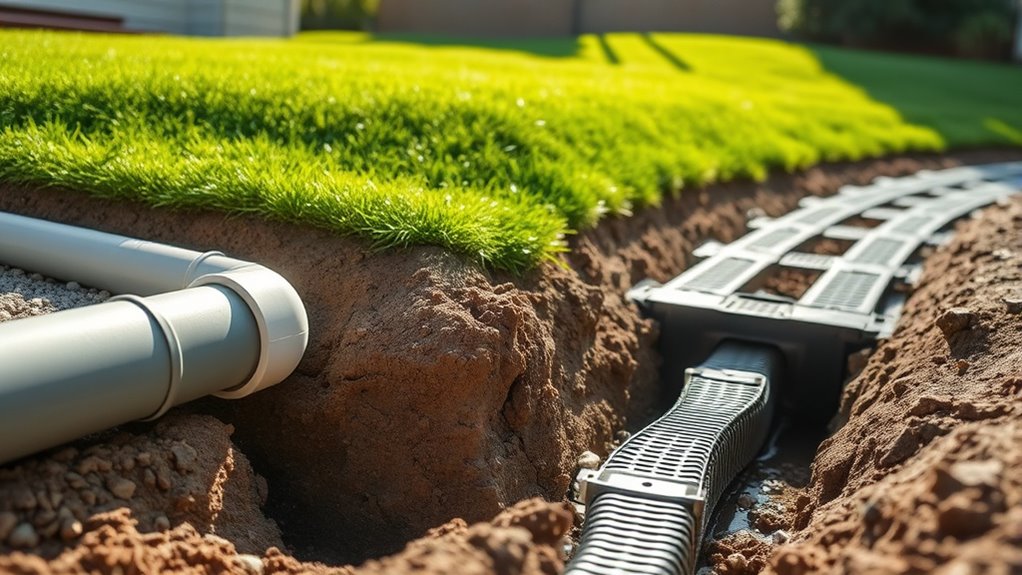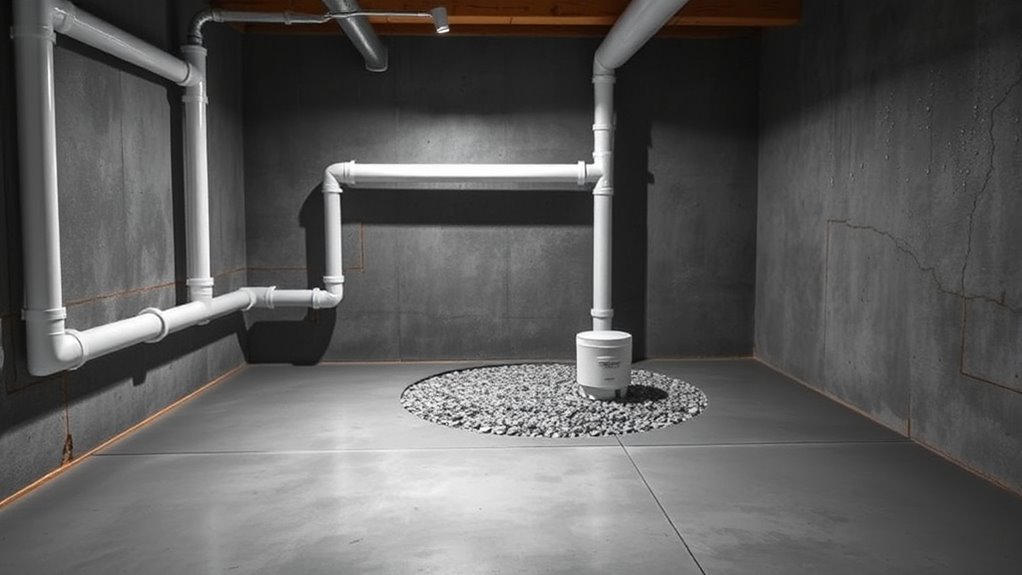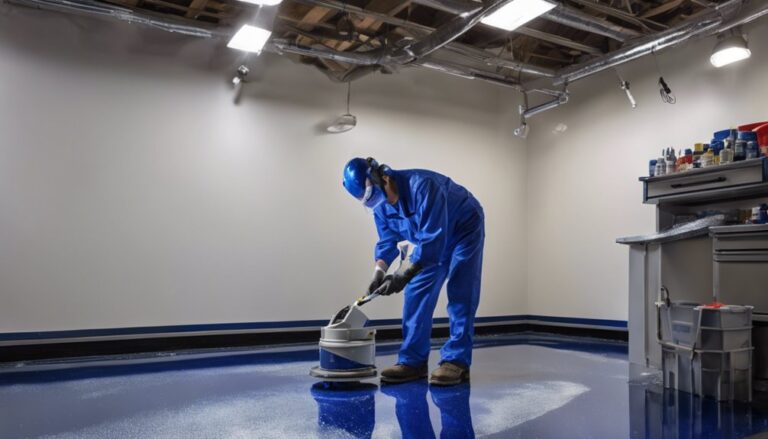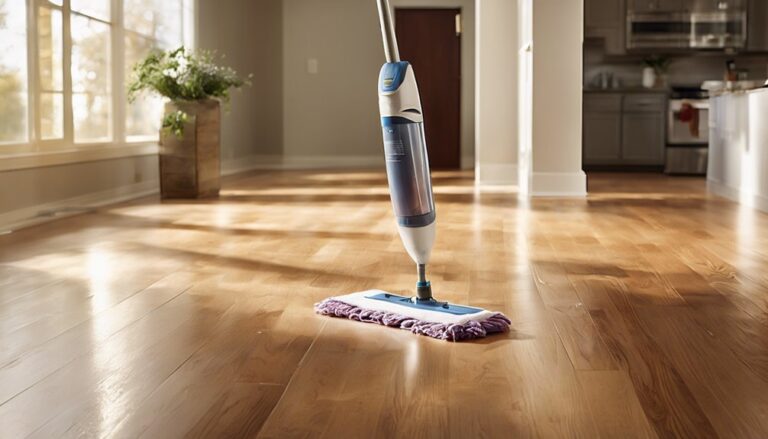To fix hydrostatic pressure in your basement floor, start by improving exterior drainage—ensure gutters direct water away and grade soil with at least a 5% slope. Install an interior drainage system with perforated pipes and a sump pump to remove water accumulating beneath your floor. Apply waterproofing sealants or membranes after preparing surfaces to block moisture infiltration. Persistent issues or structural concerns may require professional assessment. Explore these steps further to effectively mitigate pressure and preserve your foundation’s integrity.
Understanding Hydrostatic Pressure and Its Effects

Hydrostatic pressure refers to the force exerted by standing water on a surface, such as your basement sol, due to the weight of water in the surrounding soil. You need to understand that this pressure increases with depth and soil saturation, directly impacting basement moisture levels. When hydrostatic pressure builds up, it forces water through cracks and porous materials, undermining your basement’s structural integrity and promoting moisture intrusion. If you want to maintain control, recognizing how hydrostatic pressure drives basement moisture is key to preventing damage and mold growth. By comprehending these mechanics, you empower yourself to implement effective drainage and waterproofing solutions, reclaiming your space from persistent dampness and ensuring a dry, livable basement environment free from water-related restrictions.
Identifying Signs of Hydrostatic Pressure in Your Basement
Pressure buildup beneath your basement floor often reveals itself through specific physical indicators. To maintain your home’s integrity and freedom from water damage, you need to recognize these signs early. Elevated indoor humidity is a key symptom, signaling trapped moisture. Employing moisture detection tools can pinpoint problem areas before visible damage occurs. Look for:
- Cracks in the concrete floor or walls, indicating stress from pressure.
- Persistent damp spots or water pooling, even without rain.
- Warped or buckled flooring materials caused by moisture intrusion.
- Musty odors, suggesting excessive indoor humidity and mold growth.
Improving Exterior Drainage Systems

To reduce hydrostatic pressure on your basement floor, you need to optimize your exterior drainage system by ensuring proper grading and sloping away from your foundation. Regular maintenance of gutters and downspouts is essential to prevent water accumulation near your home. Additionally, installing French drains can effectively channel groundwater away, minimizing pressure buildup against your basement walls.
Grading and Sloping
Although water infiltration often originates below ground, managing surface water through proper grading and sloping is vital for mitigating basement floor issues. You need to guarantee the land around your foundation directs water away effectively. Precise landscaping techniques and drainage solutions play a significant role here. When grading your property, maintain a consistent slope of at least 6 inches over 10 feet away from your home. This prevents water pooling near your foundation, reducing hydrostatic pressure on basement walls and floors.
Key considerations include:
- Establishing a minimum 5% slope away from the foundation
- Avoiding low spots that collect water near the basement
- Integrating swales or berms to channel runoff effectively
- Using soil with good permeability to enhance drainage
Addressing grading and sloping is a fundamental step toward long-term basement dryness and structural integrity.
Gutter and Downspout Maintenance
Since effective exterior drainage starts above ground, maintaining your gutters and downspouts is essential in controlling water flow away from your basement. Regular gutter cleaning prevents debris buildup that can cause blockages, leading to water overflow near your foundation. Neglecting this maintenance increases hydrostatic pressure against basement walls and floors, risking leaks and structural damage. Additionally, installing downspout extensions directs water further from your home’s base, reducing saturation around the foundation. Make certain extensions discharge water at least 5 to 10 feet away to minimize soil erosion and pooling. By systematically inspecting, cleaning, and upgrading these components, you optimize exterior drainage efficiency, directly mitigating hydrostatic pressure on your basement floor. This proactive approach guarantees your basement remains dry and structurally sound, granting you the freedom from costly water damage repairs.
French Drains Installation
When you need to manage excess groundwater effectively, installing a French drain system offers a targeted solution for improving exterior drainage. French drain types vary, including perforated pipe drains, gravel-lined trenches, and modern prefabricated systems. Each design directs water away from your foundation, reducing hydrostatic pressure on basement floors. The french drain benefits include preventing water infiltration, minimizing soil erosion, and protecting structural integrity.
Key considerations for installation:
- Assess soil permeability and slope for ideal trench placement
- Select appropriate drain type based on site conditions
- Use geotextile fabric to prevent sediment clogging
- Verify proper outlet for water discharge away from the foundation
Installing Interior Drainage and Sump Pump Solutions

If you’re dealing with hydrostatic pressure in your basement floor, installing an interior drainage system paired with a sump pump is a highly effective solution. Interior drainage involves placing perforated pipes along the perimeter of the basement floor to collect groundwater seeping through the concrete. This system channels water to a sump basin, where the sump pump actively removes it away from your foundation. By reducing water accumulation beneath the slab, you alleviate the upward force causing hydrostatic pressure. When selecting a sump pump, prioritize models with reliable motors and backup power options to guarantee continuous operation during power outages. Proper installation and maintenance of both interior drainage and sump pump systems are essential to prevent basement flooding and preserve the structural integrity of your home, granting you freedom from persistent moisture issues.
Applying Waterproofing Sealants and Membranes
A critical step in mitigating hydrostatic pressure involves applying waterproofing sealants and membranes to your basement floor. These waterproofing products form a robust barrier that prevents water infiltration and relieves pressure buildup beneath the slab. For effective sealant application, guarantee the surface is clean, dry, and free of cracks or debris. Consider these key factors:
- Select high-performance sealants compatible with concrete substrates.
- Apply membranes continuously, avoiding seams or gaps.
- Use multiple layers for enhanced durability and resistance.
- Allow adequate curing time as specified by the manufacturer.
Enhancing Basement Floor Drainage Techniques
While waterproofing sealants and membranes create a barrier against water infiltration, managing the water that accumulates beneath your basement floor requires effective drainage solutions. Enhancing basement floor drainage techniques involves installing subsurface drainage systems, such as perforated pipes embedded in gravel-filled trenches, to efficiently collect and redirect water. These systems facilitate water diversion away from the foundation, reducing hydrostatic pressure exerted on the floor. You should guarantee proper slope design within the drainage layout to promote gravity-driven flow toward sump pumps or exterior drains. Additionally, integrating drainage mats or channels beneath the floor slab can improve water capture and movement. By implementing precise drainage systems focused on systematic water diversion, you maintain structural integrity and prevent moisture-related damage, granting you greater freedom from persistent basement water issues.
When to Consult a Professional Waterproofing Contractor
Whenever persistent hydrostatic pressure issues surpass standard DIY remedies or drainage enhancements, consulting a professional waterproofing contractor becomes crucial. You’ll want to engage experts who demonstrate verified contractor qualifications to guarantee effective, lasting solutions. Additionally, understanding project timelines will help you plan and minimize disruptions.
Consider hiring a professional if you encounter:
- Complex water infiltration beyond visible cracks or seepage
- Structural concerns linked to sustained pressure on basement walls or floor
- Inadequate results from previous DIY or minor drainage fixes
- Necessity for thorough waterproofing systems requiring specialized equipment




